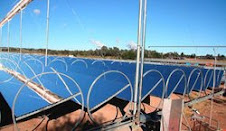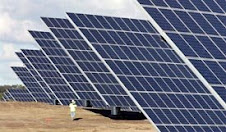The Impact of State Clean Energy Fund Support for Utility-Scale Renewable Energy Projects
from http://eetd.lbl.gov/ea/ems/cases/LBNL-56422.pdf
Mark Bolinger and Ryan Wiser
Lawrence Berkeley National Laboratory
Introduction
At least fourteen states across the U.S. have established funds to promote the development and commercialization of renewable energy technologies. Most often financed by a small surcharge on retail electricity rates, these funds currently collect more than $500 million per year in aggregate in support of renewables. At this funding level, state clean energy funds are positioned to be a major driver of renewable energy development.
Though state clean energy funds have pursued a variety of approaches in the use of their funds, support for the deployment of utility-scale renewable energy projects – such as commercial wind, biomass, and geothermal projects – has been a principal target of most funds. This case study, and the database it describes, summarizes the support that clean energy funds have provided to utility-scale renewable energy projects in recent years, detailing – among other things – the amount of funds obligated and the number, capacity, and resource type of projects supported.
This case study focuses on projects supported by funds that are members of the Clean Energy States Alliance (CESA). CESA (Specifically, CESA consists of 18 funds in 14 states. More information is available at www.cleanenergystates.org)is a non-profit, membership-based, multi-state coalition consisting of most of the clean energy funds throughout the United States.1 CESA provides information and technical assistance to its member funds, and works with them to develop and promote clean energy technologies and to create and expand the markets for these technologies.
The database on which this summary is based will be updated periodically to provide a running summary of state activity and influence. The Excel database contains information on all non-photovoltaic, utility-scale (defined here as 1 MW or larger in nameplate capacity), new renewable energy projects (whether currently on line or not) that have received (or been obligated) construction- or production-related financial support from CESA-member clean energy funds. The database does not include projects that have received only pre-development support; nor does it cover R&D or other non-deployment activities. In addition, several clean energy funds, including those in California and New York, now provide direct financial assistance to projects participating in each state’s renewables portfolio standard (RPS) – the database does not include such RPS-related support.
The database includes both project and incentive information, to the extent readily available. Project information includes: project location, resource type (e.g., wind, geothermal, etc.), nameplate capacity, project participants (e.g., developer/owner), project status (i.e., online, pending, or canceled), online date (if applicable), and power purchase agreement (PPA) counterparty (if applicable). Incentive information includes: supporting clean energy fund, incentive type (e.g., grant vs. production incentive vs. loan), original and revised incentive amount, date of incentive award, solicitation name (if any), and treatment of the project’s tradable renewable certificates (TRCs – i.e., whether the fund places any restrictions on the sale of TRCs from the project). Finally, in addition to reporting the incentive as it is actually structured, we also normalize all incentives to their equivalent 5-year production incentive value in order to facilitate broad comparisons across projects, technologies, and clean energy funds.
The remainder of this report provides summary information compiled from the database as of March 2006. For more detailed information on individual states or projects, see the actual database itself, which can be accessed at http://eetd.lbl.gov/ea/ems/cases/Large_Renewables_Database.xls.
Key Findings
1. State clean energy fund support for utility-scale renewable energy projects is significant.
Of the fourteen states with CESA-member clean energy funds, eight have provided construction or operational support to utility-scale renewable energy projects. As shown in Figure 1 and Table 1, since 1998, clean energy funds in these eight states have set aside or obligated more than $475 million in construction or operational support for 250 renewable energy projects totaling 2,642 MW. After accounting for cancellations – 16 projects totaling 393 MW have had their incentives canceled to date2 – and penalties due to missed milestones, the total amount of funding currently obligated stands at nearly $400 million. So far, 178 projects totaling 1,116 MW have been built, while 56 projects totaling 1,133 MW are still in the development pipeline.
Four wind projects in New York account for 267 MW of the 393 MW that have had incentives canceled to date. These four projects agreed to forfeit their incentives, as required, in order to participate in New York’s RPS. One of these four projects has since received support from NYSERDA under the state’s RPS (in the form of a 10-year TRC purchase). As noted earlier, though, our database does not include this RPS-related support.
2. California has been the biggest player historically, but other states have been more active recently.
Among the states listed in Table 1 (see http://eetd.lbl.gov/ea/ems/cases/LBNL-56422.pdf), California clearly dominates, accounting for roughly half of total dollars obligated, as well as capacity obligated and online. This not only reflects the sheer size of California’s renewable energy program, but also its early initiative: California’s first auction of production incentives to utility-scale renewable energy projects occurred in June 1998, roughly two years prior to similar activity in other states. By the same token, however, California has not encumbered new funding for such projects since 2001,3 and has also experienced difficulty in bringing funded projects online – 66% of all pending capacity is in California. Meanwhile, much of the activity in other states has been more recent.
This lapse is due in large part to the creation of the California RPS, under which the role of California’s program that formerly targeted new utility-scale projects has changed to providing supplemental energy payments (SEPs) intended to cover the above-market cost of RPS contracts. Though no RPS contracts approved to date have required SEPs, such support would not be included in our database regardless, since it is RPS-related.
The amount of renewable generating capacity supported by state funds continues to increase, though the growth rate has slowed markedly. As shown in Figure 2, with the exception of 1999 and 2004, the amount of renewable generating capacity being supported by these eight states has risen each year. Likewise, the amount of obligated capacity that has come online has also risen, with proportionally larger increases in 2001, 2003, and 2005 – all years in which the federal production tax credit (PTC) for wind power was scheduled to expire, thereby encouraging completion of wind projects prior to year’s end (see Figure 3 for a clearer, wind-specific view of this phenomenon). Even so, the rapid growth in new obligated capacity in the early years has slowed markedly since 2003, perhaps partly in response to the slower-than-expected pace of development among projects already obligated funding. The transition of California and New York towards supporting such projects through RPS policies has no doubt also played a role in slowing the growth of new obligated capacity.
Utility-scale Alternative Energy Funding study continues at:
Lawrence Berkley Renewable Energy Funding Study
Best Green Stocks Investing Blog
Subscribe to:
Post Comments (Atom)
Yuya Joe Blog
Lake Ontario Waterkeeper
The Daily Beast -Politics Blog
21stArch.com - 21st Century Architecture
Original Joe College Blog
WikiLeaks Foreign Policy Analysis
AGreenRealtor.com Real Estate Blog - Ecology Energy Efficiency
Best Green Stocks Investing Blog
PV Intell Photovoltaic Solar Stocks Investing
SEARCH Leading Alternative Energy and Ethical Investing websites

Custom Search
Daily Kos
Rare Earth Stocks Research
Patrick MacManus's Blog Peace and Collaborative Development
BeesTreesFrogsElephants.com - Nature and Ecology Blog
Research Green Energy stocks, Clean Energy investing information
Find wind power investing info online, clean energy mutual funds, geothermal stocks, solar energy investments.

Green Energy Investing Network:
Green Stocks Investing Clean Power Blog
SolarIntell.com Renewable Power Investing Website
Wind Intell.com Wind Energy Stocks Company Links
Geothermal Power Investing Public Companies
PV Intell.com Leading Photovoltaic Solar Energy Stocks

Custom Search
Green Energy Investing Network:
Green Stocks Investing Clean Power Blog
SolarIntell.com Renewable Power Investing Website
Wind Intell.com Wind Energy Stocks Company Links
Geothermal Power Investing Public Companies
PV Intell.com Leading Photovoltaic Solar Energy Stocks





No comments:
Post a Comment